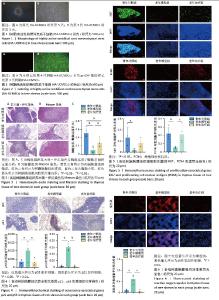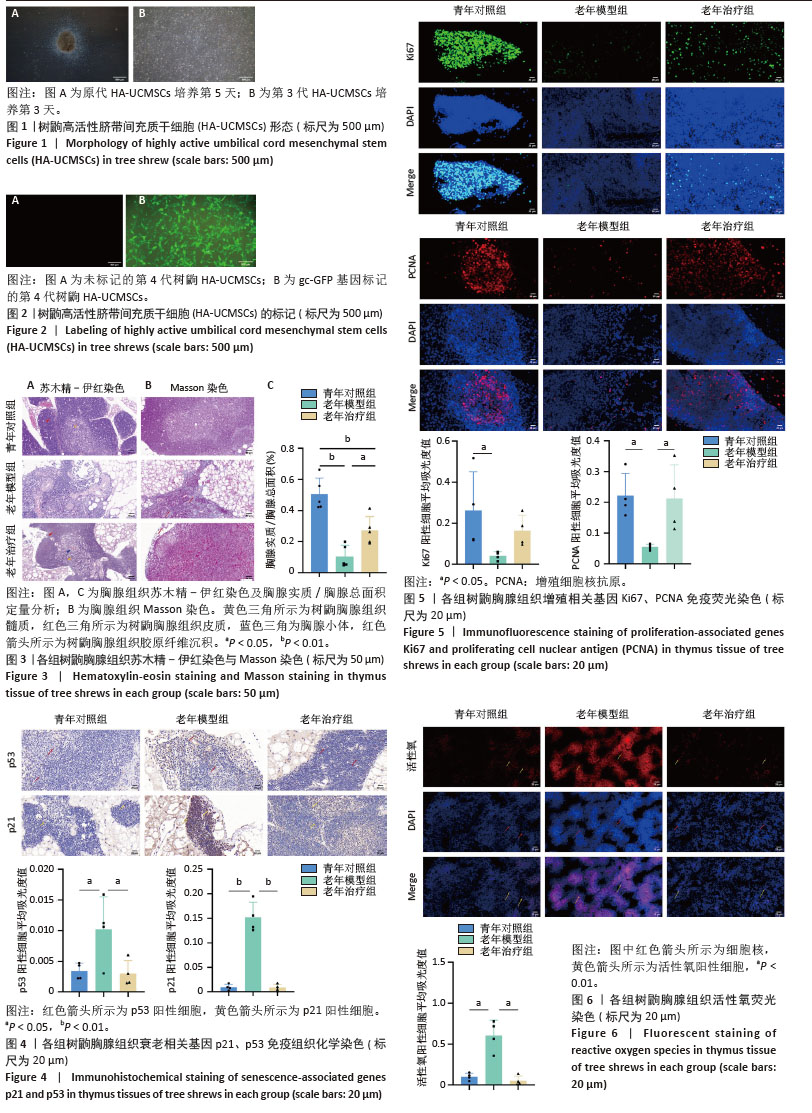[1] RUIZ PÉREZ M, VANDENABEELE P, TOUGAARD P. The thymus road to a T cell: migration, selection, and atrophy. Front Immunol. 2024;15: 1443910.
[2] 潘杭,朱向情,何洁,等.骨髓间充质干细胞对衰老猕猴胸腺及脾脏结构和功能的影响[J].中国组织工程研究,2023,27(19): 2953-2959.
[3] THAPA P, FARBER DL. The Role of the Thymus in the Immune Response. Thorac Surg Clin. 2019;29(2):123-131.
[4] MITTELBRUNN M, KROEMER G. Hallmarks of T cell aging. Nat Immunol. 2021;22(6):687-698.
[5] LIU Z, LIANG Q, REN Y, et al. Immunosenescence: molecular mechanisms and diseases. Signal Transduct Target Ther. 2023;8(1): 200.
[6] LIANG Z, DONG X, ZHANG Z, et al. Age-related thymic involution: Mechanisms and functional impact. Aging Cell. 2022;21(8):e13671.
[7] ABBOTT A. Hacking the immune system could slow ageing - here’s how. Nature. 2024;629(8011):276-278.
[8] DAHLQUIST KJV, HUGGINS MA, YOUSEFZADEH MJ, et al. PD1 blockade improves survival and CD8+ cytotoxic capacity, without increasing inflammation, during normal microbial experience in old mice. Nat Aging. 2024;4(7):915-925.
[9] AMOR C, FERNÁNDEZ-MAESTRE I, CHOWDHURY S, et al. Prophylactic and long-lasting efficacy of senolytic CAR T cells against age-related metabolic dysfunction. Nat Aging. 2024;4(3):336-349.
[10] YANG D, SUN B, LI S, et al. NKG2D-CAR T cells eliminate senescent cells in aged mice and nonhuman primates. Sci Transl Med. 2023; 15(709):eadd1951.
[11] DONG L, LI X, LENG W, et al. Adipose stem cells in tissue regeneration and repair: From bench to bedside. Regen Ther. 2023;24:547-560.
[12] WANG JV, SCHOENBERG E, ZAYA R, et al. The rise of stem cells in skin rejuvenation: A new frontier. Clin Dermatol. 2020;38(4):494-496.
[13] DOHERTY DF, ROETS LE, DOUGAN CM, et al. Mesenchymal stromal cells reduce inflammation and improve lung function in a mouse model of cystic fibrosis lung disease. Sci Rep. 2024;14(1):30899.
[14] SHI Y, WANG Y, LI Q, et al. Immunoregulatory mechanisms of mesenchymal stem and stromal cells in inflammatory diseases. Nat Rev Nephrol. 2018;14(8):493-507.
[15] AGUIAR KOGA BA, FERNANDES LA, FRATINI P, et al. Role of MSC-derived small extracellular vesicles in tissue repair and regeneration. Front Cell Dev Biol. 2023;10:1047094.
[16] HARRELL CR, JOVICIC N, DJONOV V, et al. Mesenchymal Stem Cell-Derived Exosomes and Other Extracellular Vesicles as New Remedies in the Therapy of Inflammatory Diseases. Cells. 2019;8(12):1605.
[17] WANG K, YAO X, LIN SQ, et al. Cellular and molecular mechanisms of highly active mesenchymal stem cells in the treatment of senescence of rhesus monkey ovary. Stem Cell Res Ther. 2024;15(1):14.
[18] 叶丽,田川,赵晓娟,等.高活性脐带间充质干细胞干预老年树鼩衰老脾脏的作用与机制[J].中国组织工程研究,2025,29(19): 4000-4010.
[19] LÓPEZ-OTÍN C, BLASCO MA, PARTRIDGE L, et al. Hallmarks of aging: An expanding universe. Cell. 2023;186(2):243-278.
[20] JURICIC P, LU YX, LEECH T, et al. Long-lasting geroprotection from brief rapamycin treatment in early adulthood by persistently increased intestinal autophagy. Nat Aging. 2022;2(9):824-836.
[21] LIU B, ZHANG J, ZHANG J, et al. Metformin prevents mandibular bone loss in a mouse model of accelerated aging by correcting dysregulated AMPK-mTOR signaling and osteoclast differentiation. J Orthop Translat. 2024;46:129-142.
[22] YOSHIDA K, LIU Z, KUBO Y, et al. Spermidine alleviates thymopoiesis defects and aging of the peripheral T-cell population in mice after radiation exposure. Exp Gerontol. 2025;199:112646.
[23] HUANG M, YE A, ZHANG H, et al. Siwu decoction mitigates radiation-induced immune senescence by attenuating hematopoietic damage. Chin Med. 2024;19(1):167.
[24] FAHY GM, BROOKE RT, WATSON JP, et al. Reversal of epigenetic aging and immunosenescent trends in humans. Aging Cell. 2019; 18(6):e13028.
[25] SHEN M, ZHOU L, FAN X, et al. Metabolic Reprogramming of CD4+ T Cells by Mesenchymal Stem Cell-Derived Extracellular Vesicles Attenuates Autoimmune Hepatitis Through Mitochondrial Protein Transfer. Int J Nanomedicine. 2024;19:9799-9819.
[26] YORDANOVA A, IVANOVA M, TUMANGELOVA-YUZEIR K, et al. Umbilical Cord Mesenchymal Stem Cell Secretome: A Potential Regulator of B Cells in Systemic Lupus Erythematosus. Int J Mol Sci. 2024;25(23):12515.
[27] YU-TAEGER L, EL-AYOUBI A, QI P, et al. Intravenous MSC-Treatment Improves Impaired Brain Functions in the R6/2 Mouse Model of Huntington’s Disease via Recovered Hepatic Pathological Changes. Cells. 2024;13(6):469.
[28] ALDALI F, DENG C, NIE M, et al. Advances in therapies using mesenchymal stem cells and their exosomes for treatment of peripheral nerve injury: state of the art and future perspectives. Neural Regen Res. 2025;20(11):3151-3171.
[29] LEE WJ, CHO KJ, KIM GW. Mitigation of Atherosclerotic Vascular Damage and Cognitive Improvement Through Mesenchymal Stem Cells in an Alzheimer’s Disease Mouse Model. Int J Mol Sci. 2024;25(23):13210.
[30] 朱凤昌,叶潇,崇小萌,等.国际细胞治疗临床研究发展现状及监管政策研究[J].中国药物评价,2024,41(4):257-264.
[31] WU X, CHANG Q, ZHANG Y, et al. Relationships between body weight, fasting blood glucose concentration, sex and age in tree shrews (Tupaia belangeri chinensis). J Anim Physiol Anim Nutr (Berl). 2013;97(6): 1179-1188.
[32] YAO YG, LU L, NI RJ, et al. Study of tree shrew biology and models: A booming and prosperous field for biomedical research. Zool Res. 2024;45(4):877-909.
[33] SAVINO W, DALMAU SR, DEALMEIDA VC. Role of extracellular matrix-mediated interactions in thymocyte migration. Dev Immunol. 2000; 7(2-4):279-291.
[34] YING Y, TAO N, ZHANG F, et al. Thymosin β4 Regulates the Differentiation of Thymocytes by Controlling the Cytoskeletal Rearrangement and Mitochondrial Transfer of Thymus Epithelial Cells. Int J Mol Sci. 2024;25(2):1088.
[35] BOCK-MARQUETTE I, MAAR K, MAAR S, et al. Thymosin beta-4 denotes new directions towards developing prosperous anti-aging regenerative therapies. Int Immunopharmacol. 2023;116:109741.
[36] MANSILLA SF, DE LA VEGA MB, CALZETTA NL, et al. CDK-Independent and PCNA-Dependent Functions of p21 in DNA Replication. Genes (Basel). 2020;11(6):593.
[37] WENG M, JAUCH R. Advancements in personalized stem cell models for aging-related neurodegenerative disorders. Neural Regen Res. 2024;19(11):2333-2334.
[38] BALAMURLI G, LIEW AQX, TEE WW, et al. Interplay between epigenetics, senescence and cellular redox metabolism in cancer and its therapeutic implications. Redox Biol. 2024;78:103441.
|



